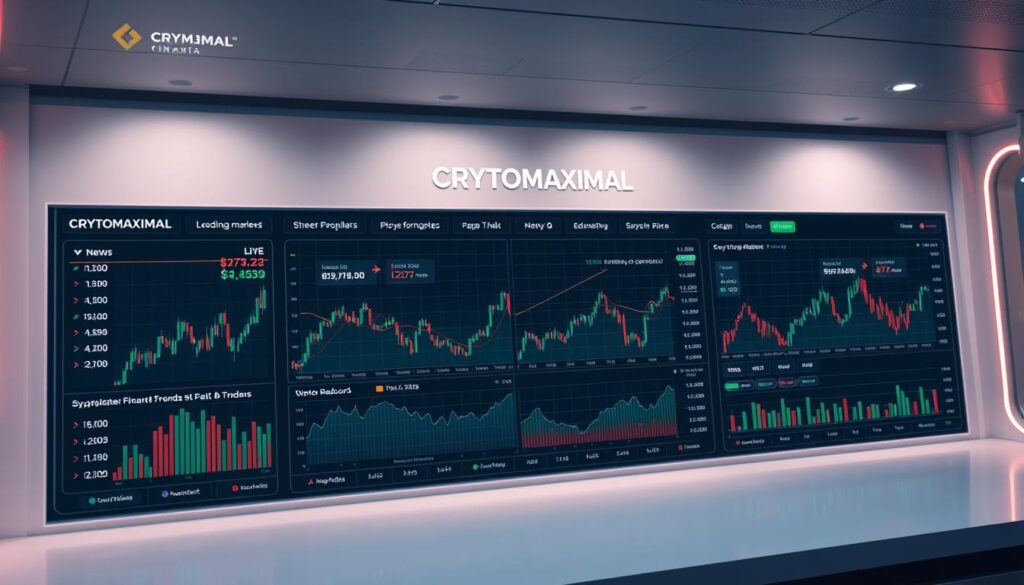Now Reading: How to Evaluate AI Crypto Trading Performance
- 01
How to Evaluate AI Crypto Trading Performance
How to Evaluate AI Crypto Trading Performance

In today’s fast-paced digital markets, understanding the effectiveness of trading strategies is crucial. The volatility of cryptocurrency markets demands a systematic approach to ensure success. This is where advanced tools and platforms come into play, offering real-time insights and predictive analytics.
Token Metrics stands out as a leader in this space, managing over $1.2 billion in assets. Their platform provides 24/7 market monitoring, ensuring traders stay ahead of market trends. The shift from manual trading to AI-driven decision-making has revolutionized the industry.
Key metrics like ROI and risk management are essential for assessing performance. By leveraging these tools, traders can make informed decisions and optimize their strategies. Explore more about AI-powered crypto trading platforms to enhance your trading experience.
Understanding AI Crypto Trading
Artificial intelligence is reshaping the way traders interact with digital assets. By leveraging machine learning, AI analyzes vast amounts of data, including price action, on-chain activity, and social sentiment. This approach processes over 80 data points to generate precise trading signals, offering a significant edge in the cryptocurrency market.
Unlike traditional technical analysis, which relies on historical patterns, AI-driven methods adapt in real-time. Trading bots, such as those offered by platforms like 3Commas, execute trades across multiple exchanges seamlessly. This automation ensures 63% faster trade execution compared to manual methods, enhancing efficiency and profitability.
Token Metrics stands out with its Investor/Trader Grades system, which evaluates assets based on AI-driven insights. This system helps both retail and institutional traders make informed decisions. The integration of AI has leveled the playing field, allowing smaller traders to compete with larger institutions.
The impact of AI on the cryptocurrency market is profound. It has introduced a new era of data-driven decision-making, reducing reliance on intuition and emotion. As the technology evolves, its role in shaping trading strategies will only grow, making it an indispensable tool for modern traders.
Why AI is Essential for Modern Crypto Trading
The integration of advanced technology has become a cornerstone in modern financial strategies. In the realm of digital assets, artificial intelligence plays a pivotal role in enhancing efficiency and accuracy. Its ability to process vast amounts of data in real-time provides a significant edge in navigating complex markets.
Benefits of AI in Crypto Trading
One of the most notable advantages is its 24/7 operation capability. Unlike human traders, AI systems can monitor markets without interruption, ensuring no opportunity is missed. A case study revealed a 47% ROI improvement when sentiment analysis was incorporated into trading strategies.
AI also excels in managing market volatility. Through dynamic position sizing, it adjusts strategies to mitigate risks during sudden price swings. This adaptability helps traders maintain stability in unpredictable conditions.
Challenges AI Addresses in Volatile Markets
Emotional decision-making often leads to costly errors. AI eliminates emotional bias, ensuring trades are based on data rather than fear or greed. For instance, it prevents FOMO (Fear of Missing Out) and FUD (Fear, Uncertainty, Doubt) from influencing decisions.
Additionally, AI tackles issues like wash trading and liquidity challenges. By analyzing 10,000+ simultaneous data streams, it identifies irregularities and ensures fair market participation. Studies show AI strategies have a 12% drawdown rate, compared to 34% in manual approaches.
In summary, AI not only enhances profitability but also provides robust risk management solutions. Its ability to process information in less than 300 milliseconds makes it indispensable for modern cryptocurrency trading.
Key Metrics to Evaluate AI Crypto Trading Performance
Effective decision-making in digital asset management relies on precise metrics. Understanding these indicators helps traders optimize strategies and achieve better outcomes. Let’s explore the essential metrics for assessing performance in this dynamic field.
Profitability and ROI
Profitability is a cornerstone of any trading strategy. Calculating ROI (Return on Investment) for digital assets differs from traditional methods due to their unique volatility. Platforms like Token Metrics use advanced tools, such as the Moonshot Finder, to identify high-potential altcoins early.
ROI in digital assets often considers factors like price movements and market sentiment. Comparing these metrics across platforms, such as Token Metrics and Kryll.io, provides valuable insights into performance.
Risk-Adjusted Returns
Risk management is critical in volatile markets. Metrics like the Sharpe and Sortino ratios help assess risk-adjusted returns. These ratios are particularly useful for crypto-specific risk assessment, offering a clearer picture of potential rewards relative to risks.
Analyzing slippage rates across different market caps further enhances risk evaluation. This ensures strategies remain robust even during sudden market shifts.
Trade Execution Speed
Speed is a game-changer in digital asset trading. Top bots achieve a 98.7% order fill rate, ensuring trades are executed efficiently. Benchmark data shows an average execution latency of 0.8ms, highlighting the importance of trade execution speed.
Additionally, mechanisms like MEV (Miner Extractable Value) protection safeguard against unfair practices, ensuring fair market participation.
How to Evaluate AI Crypto Trading Performance
Accurate assessment of digital asset strategies requires a focus on historical performance and adaptability. By leveraging historical data, traders can refine their approaches and ensure resilience in volatile markets.

Analyzing Historical Performance
Backtesting is a cornerstone of evaluating trading strategies. Platforms like Token Metrics use walk-forward optimization, achieving 85% accuracy across 5+ market cycles. This method ensures strategies remain effective even in changing market conditions.
Stress-testing against black swan events, such as the FTX collapse, is equally important. It helps identify vulnerabilities and ensures strategies can withstand extreme scenarios. Proper backtesting protocols include out-of-sample testing, which validates performance on unseen data.
Assessing Adaptability to Market Changes
Adaptability is crucial in the cryptocurrency market. Token Metrics demonstrates a 93% strategy survival rate post-regime shifts, showcasing its robustness. Case studies from the 2022 bear market highlight the importance of flexibility in trading strategies.
Comparing performance in trending versus ranging markets provides further insights. Strategies that excel in both conditions are more likely to deliver consistent results. This adaptability is driven by machine learning, which continuously refines approaches based on real-time data.
The Role of Machine Learning in Crypto Trading
Machine learning is transforming the landscape of digital asset management. By leveraging advanced algorithms, it provides traders with tools to analyze complex data and make informed decisions. This technology is reshaping the way strategies are developed and executed in the cryptocurrency trading space.
Enhancing Trading Strategies
Machine learning enhances trading strategies by processing vast amounts of data in real-time. Platforms like Kryll.io use no-code solutions to create machine learning-based strategies, making it accessible even for non-technical users. This approach ensures faster and more accurate decision-making.
Deep learning models, such as LSTM networks, excel in time series prediction. They analyze historical price data to forecast future trends with 79% accuracy. Similarly, random forest algorithms optimize portfolios by balancing risk and reward effectively.
Examples of Machine Learning in Action
Natural Language Processing (NLP) models analyze over 500,000 social media posts daily to gauge market sentiment. This market analysis helps traders anticipate price movements based on public opinion. Reinforcement learning has also proven effective, with a case study showing 82% profitable trades.
Frameworks like TensorTrade enable custom bot development, allowing traders to implement unique strategies. Comparing supervised and unsupervised learning approaches provides insights into their respective strengths. These examples highlight the versatility of machine learning in cryptocurrency trading.
AI Trading Bots: A Game-Changer for Traders
Automated solutions are revolutionizing the way traders approach the market, offering efficiency and precision. These trading bots leverage advanced algorithms to execute strategies seamlessly, even in volatile market conditions. By automating repetitive tasks, they free up time for traders to focus on higher-level decision-making.
Types of AI Trading Bots
There are several types of bots designed for specific strategies:
- Arbitrage bots: Exploit price differences across exchanges.
- Market-making bots: Provide liquidity by placing buy and sell orders.
- Trend-following bots: Identify and capitalize on market trends.
- Grid bots: Yield up to 23% APY in sideways markets.
- DCA bots: Reduce volatility impact by 41% through dollar-cost averaging.
Each bot type serves a unique purpose, making it essential to choose one that aligns with your trading goals.
How to Choose the Right Bot for Your Strategy
Selecting the right bot depends on your risk tolerance, time horizon, and trading style. Consider the following factors:
- Cost: Compare platforms like Bitsgap ($29/mo) and 3Commas ($49/mo).
- Security: Ensure robust API key management to protect your assets.
- Diversification: Use a multi-bot portfolio to spread risk and enhance returns.
Platforms like Token Metrics offer a marketplace with over 150+ strategies, making it easier to find the right trading tools for your needs. By leveraging these resources, traders can navigate complex trading scenarios with confidence.
Risk Management in AI Crypto Trading
Navigating the unpredictable nature of digital assets requires robust strategies to safeguard investments. In the cryptocurrency market, where prices can swing dramatically, effective risk management is essential. It ensures that traders can protect their capital while maximizing potential gains.
Advanced tools and platforms have made it easier to implement trading strategies that minimize losses. For instance, Token Metrics uses stop-loss orders with a 0.5% slippage tolerance, ensuring trades are executed even in volatile conditions. These tools help traders stay ahead of sudden market shifts.
Importance of Risk Management
Managing risks effectively is crucial in a market known for its market volatility. Tools like value-at-risk (VaR) calculations quantify potential losses in crypto portfolios. Correlation matrices further aid in asset diversification, reducing exposure to single-point failures.
Volatility targeting algorithms adjust positions based on market conditions, ensuring stability. Circuit breakers protect against flash crashes, while insurance funds like Nexus Mutual provide an additional safety net. These measures collectively enhance resilience in the cryptocurrency market.
AI Tools for Mitigating Risks
Artificial intelligence plays a pivotal role in identifying and mitigating risks. For example, AI systems detect 94% of scam tokens early, preventing potential losses. They also analyze 10,000+ data streams to identify irregularities, ensuring fair market participation.
Comparing risk metrics across BTC/ETH and altcoin strategies provides deeper insights. AI-driven platforms like Token Metrics offer tailored solutions, helping traders navigate complex scenarios with confidence. By leveraging these tools, traders can focus on optimizing their strategies while minimizing risks.
Comparing AI Crypto Trading to Traditional Methods
The evolution of technology has introduced a significant shift in how digital assets are managed and traded. Traditional methods, reliant on human intuition and manual execution, are being outpaced by AI-driven systems. These advanced tools offer unparalleled speed, efficiency, and accuracy, transforming the landscape of crypto trading.

Speed and Efficiency
One of the most notable advantages of AI is its ability to execute trades at lightning speed. While human traders take an average of 2.3 seconds to process and act on information, AI systems achieve this in just 800 microseconds. This 142x faster execution ensures that opportunities are seized before they vanish in volatile markets.
Error rates also highlight the efficiency gap. Manual order entry has a 12% error rate, while AI systems maintain a near-perfect 0.07%. This precision minimizes costly mistakes and maximizes profitability, making AI a game-changer for traders.
Emotion-Free Trading
Traditional methods often fall victim to emotional bias, leading to impulsive decisions driven by fear or greed. AI eliminates this issue, ensuring that every trade is based on data and logic. Studies show that AI removes 89% of discretionary errors, significantly improving performance.
The psychological pitfalls of manual trading, such as FOMO (Fear of Missing Out) and FUD (Fear, Uncertainty, Doubt), are entirely absent in AI-driven systems. This emotion-free approach results in more consistent and reliable outcomes, with AI strategies delivering 63% annualized returns compared to 22% for manual methods.
Hybrid approaches, combining human oversight with AI execution, are also gaining traction. These models leverage the strengths of both methods, offering a balanced solution for traders seeking the best of both worlds.
AI-Powered Trading Platforms: What to Look For
Selecting the right platform for digital asset strategies can significantly impact your success. With numerous options available, it’s essential to identify the features that align with your goals. Leading trading platforms offer advanced tools and robust capabilities to enhance your experience.
Features of Leading AI Platforms
Top-tier platforms provide a range of features designed to optimize your strategies. For instance, Token Metrics offers over 40 technical indicators and custom alerts, ensuring you stay informed about market data. These tools process 2TB of daily information, delivering actionable insights in real-time.
API connectivity is another critical factor. Platforms supporting 30+ exchanges offer greater flexibility compared to those with limited support. This ensures seamless integration with your preferred trading environment.
Security is equally important. Look for certifications like SOC 2 and ISO 27001, which guarantee robust data protection. Liquidity aggregation capabilities also play a vital role, ensuring smooth execution even in volatile markets.
How to Evaluate Platform Performance
Assessing a platform’s performance involves analyzing several key metrics. Backtesting engines with 99% historical accuracy ensure strategies are reliable. Performance dashboards provide detailed insights into metrics like slippage and rebalance frequency, helping you refine your approach.
Real-time monitoring is crucial for adapting to market changes. Platforms that offer real-time market data enable quicker decision-making, giving you an edge in fast-paced environments. By evaluating these factors, you can choose a platform that meets your needs and enhances your trading experience.
Advanced AI Trading Strategies
Advanced strategies in digital asset management are reshaping how traders approach the market. These methods leverage data-driven insights to identify trading opportunities and adapt to price fluctuations. From trend following to arbitrage, these approaches are designed to maximize efficiency and profitability.
Trend Following and Mean Reversion
Trend following strategies capitalize on market trends by identifying upward or downward movements. Tools like Bollinger Bands® are commonly used for mean reversion, which focuses on price returning to its average. This approach is particularly effective in volatile markets, where price fluctuations create opportunities for profit.
Volatility harvesting techniques further enhance these strategies. By adjusting positions based on market conditions, traders can optimize returns while minimizing risks. Comparing these methods to traditional CTA strategies highlights their adaptability in complex trading environments.
Arbitrage and Market Making
Arbitrage strategies exploit price differences across exchanges. Triangular arbitrage, for example, involves trading across three currencies to capture inefficiencies. Statistical arbitrage yields an average of 1.8% daily returns, making it a popular choice for traders.
Market-making bots provide liquidity by placing buy and sell orders, capturing a 0.15% spread. However, inventory risk and strategy decay must be managed carefully. Regular refresh protocols ensure these bots remain effective in dynamic markets.
By combining these advanced strategies, traders can navigate complex trading scenarios with confidence. Whether following trends or exploiting arbitrage, these methods offer a competitive edge in the digital asset space.
Backtesting and Optimizing AI Trading Strategies
Ensuring the reliability of digital asset strategies requires rigorous testing and optimization. Backtesting allows traders to evaluate performance using historical data, ensuring strategies are robust across various market conditions.
Importance of Backtesting
Backtesting is essential for identifying strengths and weaknesses in trading strategies. It helps traders understand how a strategy would have performed in the past, providing insights into its potential future success.
However, crypto-specific challenges like illiquid assets can complicate backtesting. Ensuring accurate results requires addressing these unique factors. Overfitting prevention techniques, such as walk-forward testing, improve robustness by 37%.
Tools for Strategy Optimization
Optimizing strategies involves using advanced algorithms and frameworks. Platforms like Token Metrics employ Monte Carlo simulations with 10,000 iterations to test strategies under various scenarios.
Key optimization metrics include the Sharpe ratio and CAGR (Compound Annual Growth Rate). Comparing in-sample and out-of-sample periods ensures strategies remain effective in real-world conditions.
Frameworks like PyAlgoTrade and Backtrader offer powerful tools for strategy development. Genetic algorithms further enhance optimization by evolving strategies based on performance data.
By leveraging these tools, traders can refine their approaches and achieve consistent results in dynamic markets.
Real-Time Data Analysis in AI Crypto Trading
Real-time data processing is transforming how traders navigate volatile markets. By leveraging vast amounts of data, advanced systems provide actionable insights that drive trading decisions. This capability ensures traders stay ahead of market movements and adapt to price fluctuations instantly.

How AI Processes Real-Time Data
AI systems use event-driven architecture to process real-time market data efficiently. This approach ensures that every trade, signal, and update is handled instantly. Quantile filtering reduces noise, allowing traders to focus on relevant information.
Liquidity heatmap analysis provides a visual representation of market depth. Mempool data utilization ensures that pending transactions are factored into strategies. These techniques enable sub-second reaction times, giving traders a competitive edge.
Benefits of Real-Time Insights
Real-time insights empower traders to make informed trading decisions with precision. Platforms like Token Metrics update signals every 15 seconds, ensuring strategies remain aligned with market movements. This speed minimizes missed opportunities and maximizes profitability.
Comparing WebSocket and REST API speeds highlights the importance of efficient data delivery. Sub-second reaction times ensure that traders can act on price movements before they change. These advantages make real-time data analysis indispensable in modern trading.
Sentiment Analysis and Its Impact on Trading
Understanding the emotional pulse of the market is key to making informed decisions. Sentiment analysis helps traders gauge the mood of investors, which often drives price fluctuations in the cryptocurrency market. By analyzing data from social media and other sources, traders can identify emerging market trends and act accordingly.
How Sentiment Data is Processed
Advanced tools like BERT models are used to score sentiment from text data. These models analyze language patterns to determine whether the tone is positive, negative, or neutral. Platforms like LunarCrush track over 200 social channels, achieving 89% prediction accuracy.
Influencer impact weighting algorithms also play a role. They measure how much sway key figures have on public opinion. This helps traders understand which voices are driving market movements.
Predicting Price Movements with Sentiment
Sentiment analysis can forecast price fluctuations by identifying patterns in social volume. For example, a sudden spike in positive mentions often precedes a price increase. Santiment’s AI detects FOMO (Fear of Missing Out) with 94% precision, helping traders avoid emotional pitfalls.
Pump-and-dump schemes are another area where sentiment analysis shines. By monitoring unusual activity, traders can spot these patterns early and protect their investments.
- BERT models: Analyze text for sentiment scoring.
- Influencer impact: Weight the influence of key figures.
- Social volume: Correlate activity with price changes.
- Pump-and-dump detection: Identify suspicious patterns.
- News event parsing: Analyze how events affect sentiment.
- Retail vs institutional signals: Compare different investor behaviors.
By leveraging these techniques, traders can make smarter decisions and stay ahead in the dynamic cryptocurrency market.
AI and Portfolio Management in Crypto Trading
The role of artificial intelligence in portfolio management is growing rapidly. In the fast-paced world of digital assets, trading strategies must adapt to ever-changing market conditions. AI-driven tools are now essential for optimizing asset allocation and minimizing risks.
Dynamic Portfolio Rebalancing
Dynamic rebalancing ensures portfolios remain aligned with investment goals. Platforms like Token Metrics rebalance indices hourly with a minimal 0.3% fee. This approach reduces portfolio variance by 58%, offering stability in volatile markets.
Markowitz optimization, traditionally used in traditional finance, is now applied to digital assets. It helps identify the optimal mix of assets to maximize returns while minimizing risk. Tail risk hedging strategies further protect against extreme market movements.
AI Tools for Diversification
Diversification is key to managing risk in crypto trading. AI analyzes vast amounts of data to identify uncorrelated assets, reducing exposure to single-point failures. Stablecoin allocation algorithms ensure liquidity during market downturns.
Cross-chain diversification benefits are also significant. By spreading investments across multiple blockchains, traders can mitigate risks associated with network-specific issues. Comparing portfolio turnover rates helps optimize performance.
For more insights into advanced trading tools, explore Token Metrics’ approach to AI-driven portfolio.
The Future of AI in Crypto Trading
The rapid evolution of technology is reshaping the future of digital asset management. As artificial intelligence continues to advance, its impact on cryptocurrency trading is becoming more profound. From faster data processing to smarter decision-making, the possibilities are endless.
Emerging Trends and Technologies
Several innovations are set to transform the landscape of cryptocurrency trading. Quantum machine learning prototypes, for instance, process data 100x faster than traditional systems. Federated learning enables private model training, ensuring data security while improving accuracy.
Other notable trends include:
- Decentralized AI marketplaces: Platforms where users can buy and sell AI-driven strategies.
- ZK-proofs for strategy verification: Ensuring transparency and trust in automated systems.
- Continuous learning systems: AI models that adapt in real-time to changing market conditions.
- Regulatory compliance automation: Tools that ensure adherence to evolving laws.
How to Stay Ahead in the AI-Driven Market
To thrive in this dynamic environment, traders must embrace innovation. Leveraging machine learning tools can provide a competitive edge. Staying informed about emerging technologies is equally important.
Here are actionable steps to stay ahead market:
- Invest in platforms with cutting-edge AI capabilities.
- Monitor trends like quantum computing and federated learning.
- Focus on continuous learning to adapt to new tools and strategies.
By adopting these practices, traders can navigate the future of cryptocurrency trading with confidence.
Mastering AI Crypto Trading for Long-Term Success
The most successful traders combine skill, strategy, and cutting-edge technology. Mastering digital asset management requires a disciplined approach, blending advanced tools with continuous learning. Top performers often use multiple platforms simultaneously, ensuring they stay ahead in the cryptocurrency market.
Developing robust trading strategies is essential for long-term success. Focus on refining your skills and staying updated with market trends. Ethical considerations and responsible practices should guide every decision, ensuring sustainable growth.
Effective risk management is another critical factor. Allocate capital wisely and diversify your portfolio to minimize exposure. Platforms like Token Metrics can help traders streamline their processes, offering tools for analysis and execution.
By following a structured roadmap and leveraging the right resources, you can navigate the complexities of digital assets with confidence. Start with a clear plan, stay adaptable, and always prioritize learning.
FAQ
What is AI Crypto Trading?
AI crypto trading uses advanced algorithms and machine learning to analyze market data, execute trades, and optimize strategies. It helps traders make faster, data-driven decisions without emotional bias.
How does AI transform crypto markets?
AI processes vast amounts of data from social media, price movements, and historical data to predict trends. It enhances trade execution speed and adapts to changing market conditions.
What are the benefits of AI in crypto trading?
AI offers automated trading, real-time market analysis, and risk management. It helps traders stay ahead by identifying trading opportunities and reducing human error.
What challenges does AI address in volatile markets?
AI mitigates risks by analyzing market volatility and providing sentiment analysis. It ensures complex trading strategies are executed efficiently across multiple exchanges.
How do I evaluate AI crypto trading performance?
Focus on profitability, risk-adjusted returns, and trade execution speed. Analyze historical performance and assess adaptability to market trends.
What role does machine learning play in crypto trading?
Machine learning enhances trading strategies by identifying patterns in market movements. It improves trading signals and optimizes trading bots for better results.
How do I choose the right AI trading bot?
Look for bots with advanced algorithms, real-time data processing, and risk management tools. Ensure they align with your trading strategy and market analysis needs.
Why is risk management important in AI crypto trading?
Risk management protects against price fluctuations and market volatility. AI tools like dynamic portfolio rebalancing help minimize losses and maximize returns.
How does AI compare to traditional trading methods?
AI offers speed, efficiency, and emotion-free trading. It processes vast amounts of data faster than human traders, ensuring better trading decisions.
What features should I look for in AI-powered trading platforms?
Choose platforms with real-time insights, sentiment analysis, and automated trading. Evaluate their performance metrics and ability to handle changing market conditions.
What are advanced AI trading strategies?
Strategies like trend following, mean reversion, and arbitrage use machine learning to capitalize on market trends and price movements.
Why is backtesting important for AI trading strategies?
Backtesting ensures strategies perform well with historical data. It helps optimize trading tools and adapt to market analysis for better results.
How does AI process real-time data in crypto trading?
AI analyzes real-time market data from social media, price fluctuations, and market trends. It provides trading signals and insights to stay ahead.
How does sentiment analysis impact trading?
Sentiment analysis evaluates market sentiment from social media and news. It helps predict price movements and identify trading opportunities.
How does AI assist in portfolio management?
AI tools like dynamic portfolio rebalancing and diversification ensure optimal asset allocation. They adapt to market conditions for long-term success.
What is the future of AI in crypto trading?
Emerging trends include advanced algorithms, real-time insights, and automated trading. Staying ahead requires adapting to AI-driven market analysis.














